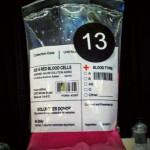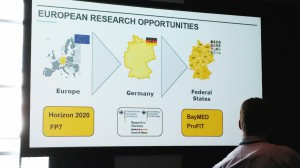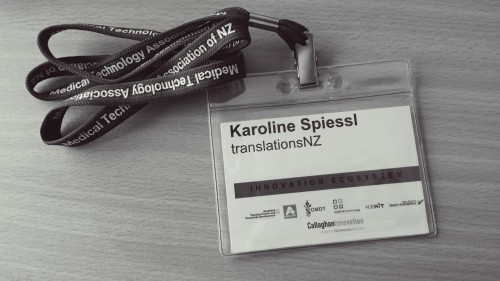As part of the HealthTech Week 2016 from 20 to 23 June in Auckland, I attended the MedTech CoRE Day and the HealthTech Innovation and Investment Workshop. As a medical translator, it was great to see the new innovations and technologies bioengineers, clinicians and researchers have come up with in New Zealand.
 MedTech CoRE Day at the HealthTech Week
MedTech CoRE Day at the HealthTech Week
Day 1 of the HealthTech Week started with an address by Professor Peter Hunter from the University of Auckland. The 2015 HealthTech award winner, Seamus Tredinnick of OssAbility, proceeded to report on the progress his company had made in the past year, not least with the help of the opportunities presented to him as part of winning the award. His company designs and produces 3D-printed implants for dogs. Following morning tea, Richard Little of Rex Bionics spoke about innovating in NZ for the international market. A very interesting talk that openly highlighted the difficulties inventors face in New Zealand, simply because of the country’s remoteness from the US or European markets. A very insightful presentation was given later in the day by Dr Stefan Harrer of IBM who talked about the TrueNorth chip and the vision to move from wearables to thinkables.
HealthTech Award Winners
Throughout the day, young researchers presented their projects which ranged from exercise games for stroke patients, new breast screening methods and MRI simulation to ventilation optimisation software and spectral imaging technology for multiple contrast agents. All in all, these were great concepts with various degrees of maturity. The winners of the Young Researchers Award can be found here: https://www.cmdt.org.nz/conference. The award for Best Translational Research Opportunity was awarded to actigaze™. The company behind it created an eye gazing software that allows screen navigation for the agility impaired or in work environments where touchscreens wouldn’t be practical for various reasons, e.g. wearing gloves.
Focus on an ageing population
Stroke and rehabilitation, self-care and remote technology were a topic throughout the day. With an ageing population, a limited number of healthcare professionals, high costs and many elderly in rural areas, the trend in NZ for healthcare innovation focuses on patients helping themselves and on remote diagnostics. All presented concepts and ideas tied in with the New Zealand Health Strategy which focuses on people-powered, closer to home and a smart system.

European Research Opportunities in Healthtech
HealthTech Innovation & Investment Workshop
The morning programme of this workshop consisted of healthtech start-ups pitching their ideas and products to potential investors. The afternoon session focused on exporting healthcare technologies made in NZ to Europe. Because of the language, NZ companies naturally like to take their products to the UK and the US (also the largest healthcare market in the world) markets. Neil Daly reported on his progress with Skin Analytics in the UK where he highlighted the funding options through the NHS, the similar environment to NZ …and the EU. This was only days before the Brexit vote, so the advantage of setting the European base up in the UK might have disappeared.
Both Nicola Taylor of Fisher & Paykel Healthcare and Monique Surges, CEO of the NZ German Business Association presented the German healthcare market to the audience. Nicola Taylor spoke about the European Regulatory Framework (the CE mark) and individual countries’ regulations, the revision of the regulations for medical devices and the medical technology clusters in Germany, e.g. in Hamburg, Stuttgart, Munich or Berlin. Monique Surges presented to the audience convincing figures about the three biggest healthcare markets in Europe that should also be considered by NZ entrepreneurs: Germany (€33 bn, 11.3% of GDP), France (€22 bn) and Switzerland (€ 7.47 bn). Medical aids are an important focus in Germany in addition to managing diabetes (highest rate in Europe), eHealth and telemedicine. David Milburn of NZTE reminded the audience of key points to consider when entering a foreign market: having the right resources to support the market entry, choosing the right markets and channels, identifying the key decision makers, the right distribution model (e.g. smaller or larger distributors), awareness of cultural issues, communication, intuition and obtaining solid legal advice.
Garth Sutherland of Adherium (chronic disease management) was probably the most internationally experienced NZ entrepreneur presenting at the workshop. He stressed the importance of physical presence in the markets where his company is active, e.g. Europe and the US. Being based in NZ, this involves a few adjustments like evening phone conferences and regular round-the-world trips. He assured fledgling entrepreneurs in the room that entering global markets from NZ was possible, but that it required a high degree of motivation and commitment. The last item on the agenda was a panel discussion comprising of a selection of the day’s speakers. Questions focused on securing investment, EU regulations and business development. The day ended with networking opportunities and the technology exhibition.
HealthTech Week worthwhile for medical translators?
Many start-ups who presented their ideas and products were still at an early stage of their development. Their priority is, understandably, securing funding, and not entering international markets. However, the two days were very valuable in that they provided an insight into the latest medical technology developments in NZ. Many ideas do have significant potential for future commercialisation, also internationally, and making new contacts was invaluable. I hope to be able to attend again next year.

.png)
